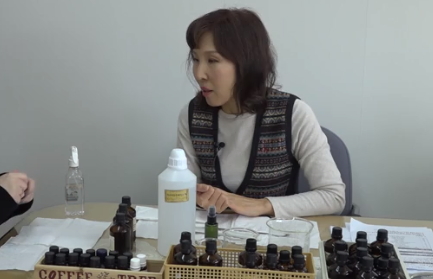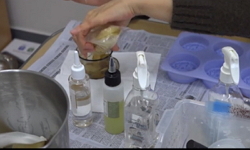In this paper, the chemical composition and the antimicrobial activity of the essential oil of Angelica archangelica L. (Apiaceae) roots from central Italy were analyzed. The major constituents of the oil were a-pinene (21.3%), d-3-carene (16.5%), lim...
http://chineseinput.net/에서 pinyin(병음)방식으로 중국어를 변환할 수 있습니다.
변환된 중국어를 복사하여 사용하시면 됩니다.
- 中文 을 입력하시려면 zhongwen을 입력하시고 space를누르시면됩니다.
- 北京 을 입력하시려면 beijing을 입력하시고 space를 누르시면 됩니다.



Essential Oil Composition and Antimicrobial Activity of Angelica archangelica L. (Apiaceae) Roots
한글로보기https://www.riss.kr/link?id=A104511289
-
저자
Daniele Fraternale (University of Urbino) ; Guido Flamini (University of Pisa) ; Donata Ricci (University of Urbino)
- 발행기관
- 학술지명
- 권호사항
-
발행연도
2014
-
작성언어
English
- 주제어
-
등재정보
KCI등재,SCOPUS,SCIE
-
자료형태
학술저널
-
수록면
1043-1047(5쪽)
-
KCI 피인용횟수
12
- DOI식별코드
- 제공처
-
0
상세조회 -
0
다운로드
부가정보
다국어 초록 (Multilingual Abstract)
In this paper, the chemical composition and the antimicrobial activity of the essential oil of Angelica archangelica L. (Apiaceae) roots from central Italy were analyzed. The major constituents of the oil were a-pinene (21.3%), d-3-carene (16.5%), limonene (16.4%) and a-phellandrene (8.7%). The oil shows a good antimicrobial activity against Clostridium difficile, Clostridium perfringens, Enterococcus faecalis, Eubacterium limosum, Peptostreptococcus anaerobius, and Candida albicans with minimum inhibitory concentration (MIC) values of 0.25, 0.25, 0.13, 0.25, 2.25, and 0.50% v/v, respectively. A weaker antimicrobial activity against bifidobacteria and lactobacilli—very useful in the intestinal microflora—has also been shown with MIC values > 4.0% v/v.
참고문헌 (Reference)
1 Sigurdsson S, "The cytotoxic effect of two chemotypes of essential oils from the fruits of Angelica archangelica L" 25 : 1877-1880, 2005
2 Nivinskiene O, "The chemical composition of the essential oil of Angelica archangelica L. roots growing wild in Lithuania" 17 : 373-377, 2005
3 Stenhagen E, "Registry of Mass Spectral Data" J. Wiley & Sons 1974
4 Jennings W, "Qualitative Analysis of Flavor and Fragrance Volatiles by Glass Capillary Gas Chromatography" Academic Press 1980
5 Swigar AA, "Monoterpenes" Aldrich Chem. Comp 1981
6 Si JM, "Intestinal microecology and quality of life in irritable bowel syndrome patients" 10 : 373-382, 2004
7 Adams RP, "Identification of Essential Oil Components by Gas Chromatography-Mass Spectroscopy" Allured Publishing 2009
8 Davies NW, "Gas chromatographic retention indices of monoterpenes and sesquiterpenes on methyl silicone and Carbowax 20M phases" 503 : 1-24, 1990
9 Pathak S, "Evaluation of antiseizure activity of essential oil from roots of Angelica archangelica Linn. in mice" 72 : 371-375, 2010
10 Hawrelak JA, "Essential oils in the treatment of intestinal dysbiosis, a preliminary in vitro study" 14 : 380-384, 2009
1 Sigurdsson S, "The cytotoxic effect of two chemotypes of essential oils from the fruits of Angelica archangelica L" 25 : 1877-1880, 2005
2 Nivinskiene O, "The chemical composition of the essential oil of Angelica archangelica L. roots growing wild in Lithuania" 17 : 373-377, 2005
3 Stenhagen E, "Registry of Mass Spectral Data" J. Wiley & Sons 1974
4 Jennings W, "Qualitative Analysis of Flavor and Fragrance Volatiles by Glass Capillary Gas Chromatography" Academic Press 1980
5 Swigar AA, "Monoterpenes" Aldrich Chem. Comp 1981
6 Si JM, "Intestinal microecology and quality of life in irritable bowel syndrome patients" 10 : 373-382, 2004
7 Adams RP, "Identification of Essential Oil Components by Gas Chromatography-Mass Spectroscopy" Allured Publishing 2009
8 Davies NW, "Gas chromatographic retention indices of monoterpenes and sesquiterpenes on methyl silicone and Carbowax 20M phases" 503 : 1-24, 1990
9 Pathak S, "Evaluation of antiseizure activity of essential oil from roots of Angelica archangelica Linn. in mice" 72 : 371-375, 2010
10 Hawrelak JA, "Essential oils in the treatment of intestinal dysbiosis, a preliminary in vitro study" 14 : 380-384, 2009
11 Chalchat JC, "Essential oil of roots (Angelica archangelica L.) optimization of distillation, location in plant and chemical composition" 9 : 311-319, 1997
12 Askari F, "Essential oil composition of the different parts of Pimpinella barbata (DC) Boiss. in Iran" 22 : 605-608, 2010
13 Ali J, "Essential oil chemical composition and antimicrobial activity of sour oranges(Citrus aurantium)peels" 5 : 1690-1693, 2012
14 Mangena T, "Comparative evaluation of the antimicrobial activities of essential oils of Artemisia afra, Pteronia incana and Rosmarinus officinalis on selected bacteria and yeast strains" 28 : 291-296, 1999
15 Kilani S, "Chemical composition, antibacterial and antimutagenic activities of essential oil from (Tunisian) Cyperus rotundus" 17 : 695-700, 2005
16 Paroul N, "Chemical composition of the volatiles of angelica root obtained by hydrodistillation and supercritical CO2 extraction" 14 : 282-285, 2002
17 Marcetic M, "Chemical composition and antimicrobial activity of essential oil of different parts of Seseli rigidum" 7 : 1091-1094, 2012
18 Wanner J, "Chemical composition and antimicrobial activity of cumin oil (Cuminum cyminum, Apiaceae)" 5 : 1355-1358, 2010
19 Fraternale D, "Chemical composition and antimicrobial activity of Salvia · jamensis essential oil" 7 : 1237-1240, 2012
20 Pavlovic M, "Chemical composition and antimicrobial activity of Anthriscus nemerosa root essential oil" 6 : 271-273, 2011
21 Maxia A, "Chemical composition and antifungal activity of essential oils and supercritical CO2 extracts of Apium nodiflorum (L.) Lag" 174 : 61-67, 2012
22 Luigi Menghini, "Chemical Composition and Inhibitory Activity Against Helicobacter pylori of the Essential Oil of Apium nodiflorum (Apiaceae)" 한국식품영양과학회 13 (13): 228-230, 2010
23 Nivinskiene O, "Changes in the chemical composition of essential oil of Angelica archangelica L. roots during storage" 14 : 52-56, 2003
24 Wedge DE, "Bioactivity guided fractionation and GC/MS fingerprinting of Angelica sinensis and Angelica archangelica root components for antifungal and mosquito deterrent activity" 57 : 464-474, 2009
25 Orhan IE, "Antimicrobial and antiviral effects of essential oils from selected umbelliferae and labiateae plants and individual essential oil components" 36 : 239-246, 2012
26 Limen-Ben Amor I, "Antimicrobial activity of essential oil isolated from Phlomis crinita Cav. ssp. mauritanica Munby" 85 : 845-849, 2008
27 Shigeharu I, "Antibacterial activity of essential oils and their major constituents against respiratory tract pathogens by gaseous contact" 47 : 565-573, 2001
28 Cos P, "Anti-infective potential of natural products, how to develop a stronger in vitro proof-of-concept" 106 : 290-302, 2006
29 Massada Y, "Analysis of Essential Oils by Gas Chromatography and Mass Spectrometry" Wiley & Sons 1976
동일학술지(권/호) 다른 논문
-
- 한국식품영양과학회
- Shirin Hooshmand
- 2014
- KCI등재,SCOPUS,SCIE
-
- 한국식품영양과학회
- Jiale Song
- 2014
- KCI등재,SCOPUS,SCIE
-
- 한국식품영양과학회
- Ciro Costagliola
- 2014
- KCI등재,SCOPUS,SCIE
-
- 한국식품영양과학회
- Xiu-Zhen Zhang
- 2014
- KCI등재,SCOPUS,SCIE
분석정보
인용정보 인용지수 설명보기
학술지 이력
| 연월일 | 이력구분 | 이력상세 | 등재구분 |
|---|---|---|---|
| 2023 | 평가예정 | 해외DB학술지평가 신청대상 (해외등재 학술지 평가) | |
| 2020-01-01 | 평가 | 등재학술지 유지 (해외등재 학술지 평가) |  |
| 2014-06-24 | 학회명변경 | 한글명 : 한국식품영양과학회지 -> 한국식품영양과학회영문명 : Journal of the Korean Society of Food Science and Nutrition -> The Korean Society of Food Science and Nutrition |  |
| 2014-04-02 | 학회명변경 | 한글명 : 한국식품영양과학회 -> 한국식품영양과학회지영문명 : 미등록 -> Journal of the Korean Society of Food Science and Nutrition |  |
| 2013-10-01 | 평가 | SCOPUS 등재 (등재유지) |  |
| 2010-01-01 | 평가 | SCI 등재 (등재유지) |  |
| 2007-01-01 | 평가 | 등재학술지 선정 (등재후보2차) |  |
| 2006-01-01 | 평가 | 등재후보 1차 PASS (등재후보1차) |  |
| 2005-01-20 | 학술지등록 | 한글명 : Journal of Medicinal Food외국어명 : Journal of Medicinal Food |  |
| 2005-01-20 | 학술지등록 | 한글명 : Journal of Medicinal Food외국어명 : Journal of Medicinal Food |  |
| 2004-01-01 | 평가 | 등재후보학술지 선정 (신규평가) |  |
학술지 인용정보
| 기준연도 | WOS-KCI 통합IF(2년) | KCIF(2년) | KCIF(3년) |
|---|---|---|---|
| 2016 | 1.88 | 0.33 | 1.35 |
| KCIF(4년) | KCIF(5년) | 중심성지수(3년) | 즉시성지수 |
| 1.09 | 0.84 | 0.536 | 0.08 |




 KCI
KCI



